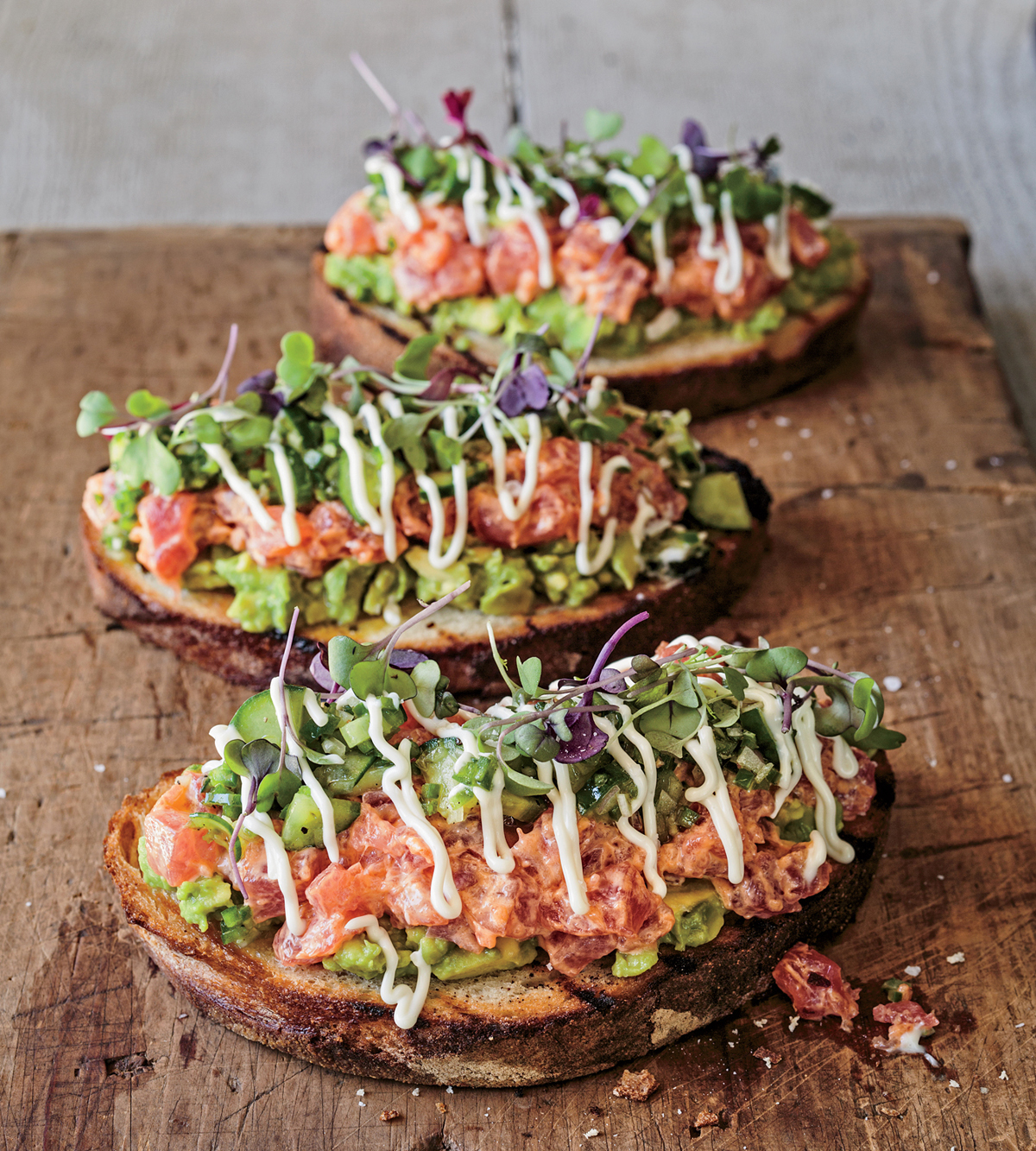
Pan con Tuna
Spicy Tuna Sandwich with Cucumber-Jalapeño Relish & Yuzu Kosho Aioli
I’m guessing that we all grow up with certain “house rules.” In mine, not eating breakfast was the equivalent of a cardinal sin. One morning, my mom showed up outside my elementary school classroom door with a tightly wrapped sandwich in her hand. I took one look at my mom’s face and regretted not eating breakfast. She pulled me outside and stood there until I finished every bite, with my friends loving every minute of the side show. I never skipped breakfast again.
Peruvians eat a lot of sandwiches for breakfast and brunch. With my mom, it was either Pan con Chicharrón (page 70) or pan con tuna, the Peruvian version of a tuna sandwich. I still love a good pan con tuna. It is usually made with canned tuna, but I’ve upgraded over the years to sushi-grade fish. I also like to play around with different condiments like yuzu kosho aioli and a Sriracha version, and I serve the sandwiches open-faced so I have more options for parties, picnics, or even just a weeknight dinner. I’ve made these sandwiches into all kinds of things, from giant hoagies with two-foot long baguettes for fútbol matches to elegant crostini on one-bite toasts for cocktail parties. They are also a good use of leftover trimmings and scrapings from sushi-grade tuna (see sidebar, page 75). Trim your fish when you get home, and you’ve got an excuse to make this sandwich for lunch.
- 1 cup finely diced and scraped trimmings from sushi-quality tuna (see sidebar, page 75) (about 8 ounces)
- About ¼ cup Sriracha aioli (page 38), or to taste
- 3 (½-inch-thick) slices from a large, fat sourdough country loaf, cut in half, or 12 (¼-inch-thick) slices sourdough baguette (about 2 inches long), or 24 melba toasts or other small crackers
- Extra-virgin olive oil
- 1 to 2 ripe large Hass avocados
- Juice of ½ lime or ¼ lemon
- Kosher salt
- Cucumber-Jalapeño Relish (recipe)
- ¼ to ½ cup yuzu kosho aioli (page 38), or more Sriracha aioli
1 In a medium bowl, mix together the tuna and the Sriracha aioli. Cover and refrigerate while you make the other sandwich components, or for up to 4 hours.
2 If making sandwiches or crostini, brush the bread lightly with olive oil and lightly grill or broil both sides until crispy. In a medium bowl, mash together the avocados, lime juice, and a nice pinch of salt.
3 To assemble the sandwiches or crostini, generously spread the smashed avocados on each slice of bread, like a mayonnaise. I like a thick, ½-inch layer of avocado, but use however much you’d like. Divide the spicy tuna among the bread and top with the cucumber-jalapeño relish. Dollop or drizzle the yuzu kosho aioli on the top, and you’re ready to go.
4 If you are making mini cocktail toasts, spoon 2 teaspoons of the spicy tuna on each toast, followed by a dollop of cucumber-jalapeño relish. Put the yuzu kosho aioli in a squeeze bottle, if you have one, and squeeze a little on top. Or, use a ½-teaspoon measuring spoon to dollop the aioli on top of the relish, or to taste.

Cucumber-Jalapeño Relish
Makes about 1 cup
Every home cook piles his or her own condiments on pan con tuna, but the toppings are usually pretty simple, maybe Salsa Criolla (page 44) or just onions mixed with ají amarillo or rocoto pepper paste and mayonnaise. The jalapeños in this relish are my tribute to an American tuna sandwich, as you see the peppers so much here. I also really like all of the flavors together, with the light crunch of cucumbers against the more intense red onions, a little cilantro, and the jalapeños for a little heat.
Japanese and Persian cucumbers have fewer seeds and thinner skins than the chubby garden variety at many grocery stores, so you don’t have to bother with peeling or seeding them. If you use a thick-skinned variety with a lot of seeds, peel and seed them before chopping.
- ½ cup finely chopped Japanese or Persian cucumbers
- ½ cup finely chopped red onion
- About ⅓ bunch finely chopped fresh cilantro, leaves and top two-thirds of the stems
- ½ to 1 medium jalapeño, seeded and finely chopped
- 3 tablespoons extra-virgin olive oil
- ¼ teaspoon finely ground black pepper
- ¼ teaspoon kosher salt, or to taste
Toss together all of the ingredients in a medium bowl, adding more or less jalapeño to taste. Taste, and add more salt as needed. Serve the relish right away.
Atún (Tuna)
My mom could turn every last piece of any meat, fish, or poultry we were lucky enough to have on the table into something good to eat. I think it is even more importante with fish like tuna to use as much as you can.
Tuna is an amazing fish, incredibly engineered and as efficient as a race car, with a delicate, buttery flavor and texture that almost melts on your tongue. Bluefin is the equivalent of the Incan gold of the species and the most prized for sushi. The best-quality fish can fetch hundreds of thousands of dollars, especially in Japan. All that incredible flavor comes at another high price: Environmental experts say bluefin will likely disappear in our lifetime.
There are other top-quality tuna options for sushi-style dishes. Bigeye in particular has an excellent flavor, both cooked and raw. It is the tuna I use most often. There are still some overfishing issues, but you can more easily find sustainable options. The Monterey Bay Aquarium's Seafood Watch is a good resource. Even still, we need to show our respect for the whole animal.
Once, I walked in on one of my sous chefs cleaning a large, beautiful whole tuna. She had all of the scraps off to one side, destined for the trash bin (tuna meat is so dark, the head, tail, and skeleton don’t make very clean-tasting fish stock). This was a super-fresh fish—even the blood was still glistening. I gathered up the bloodiest parts of the skeleton, rinsed them in a colander to wash away all of the impurities, and slowly cooked down the blood with soy sauce, rocoto peppers, ginger, and sugar to make a soft, gummy candy (a preparation that I learned at a Japanese restaurant in London). My chefs loved it, and the "blood" candy was a good lesson that there are no excusas for letting anything go to waste. With good-quality ingredients, there is always something tasty that you can make. Worst-case scenario, at least you tried to make something new with an ingredient that would have gone in the trash anyway.
Trimming tuna: For tiraditos or any other sushi-style dishes, you want the best, nonmarbled cuts of the fish. The meat should look uniformly bright red, with very little white sinew. Sometimes, even a good steak from the fish market has a few sinewy sections that look more like a marbled beef steak. Cut those pieces off the fish and save all of the scraps. If you are trimming a skin-on fillet, scrape off the bits of flesh still clinging to the skin with the blade of a sharp knife, and save the tasty scrapings for pan con tuna or as a causa topping (see pages 73 and 101).
Gather up all of your trimmings and scrapings, and chop them again. For a superfine texture, like when making tiny one-bite cocktail toasts, I press the fish through a food mill or ricer. As you fold the tuna trimmings into mayonnaise or whatever other ingredients you are using, the tuna almost melts into the dressing.